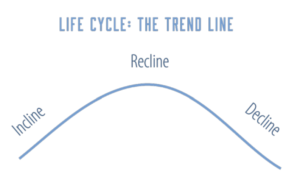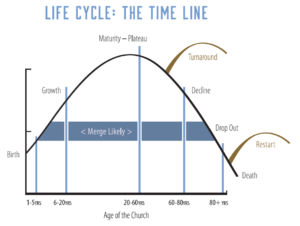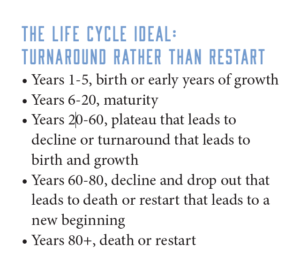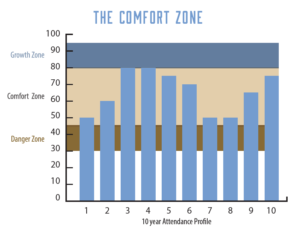Part 1. RECOGNIZE
This is the first part in a series which comes from the 2016 Turnaround 2020 Plan Book. A full version of this plan book is available by download at www.Turnaround2020.net or by hard copy from Congregational Ministries, 573-785-7746.
What Is Your Church’s Redemptive Potential?
Suppose your church became all that the Lord intended it to become? What might result? What is the full redemptive potential of a local church? Is it measured by attendance, programs, life transformation or some other metric?
A variety of factors impact the redemptive potential of any local church. Some of them are simple and practical. For example, megachurches are always found in large population centers. Villages do not contain the level of population to produce a megachurch.
Other factors are more complex and elusive. Craig Groeschel wrote a few years ago about having “It” and while sometimes “It” can be identified, it is often more obvious when “It” is missing.
In our Turnaround 2020 strategy we first take stock of the current reality. By recognizing where we are, we should be better able to chart where the Lord will lead us as we endeavor to become all that He intends us to become.
A. Church Life Cycles
Churches, like the people who comprise them, move through cycles in their existence. Some of these cycles a church moves through are life cycles. People are born, grow to maturity, then they age and die. Churches, too, are born and grow to maturity. Churches age. Some churches complete their life cycle and others discover new periods of growth and development.
Learning where a church is on its life cycle helps church leaders develop appropriate strategies. Learning life cycle status often provides a sense of urgency for church leaders as they plan for new cycles of growth and development to avoid the life cycle of decline. Life cycle may be measured by attitudes, chronology and comfort zone.
Because the life cycle is not always as predictable and smooth as many may think, it is important to avoid alarm over short periods of plateau or decline. The best possible advice for any church is to remain vigilant. Once a problem is spotted, ensure that all possible measures are taken to reverse decline before it leads to drop out and death.
 Why does a church move through these stages? What factors in the life of a church cause plateau or decline? A number of factors may influence both the speed with which a church progresses through the life cycle, and the direction a church moves in the life cycle. Some of these factors are external forces beyond the control of the congregation and other factors are internal.
Why does a church move through these stages? What factors in the life of a church cause plateau or decline? A number of factors may influence both the speed with which a church progresses through the life cycle, and the direction a church moves in the life cycle. Some of these factors are external forces beyond the control of the congregation and other factors are internal.
Life cycles simply are. They exist. For the human being there is no fountain of youth or reversal of time. A healthy lifestyle may slow the process of aging but the natural result of birth is growth, maturity, decline, and death. The human organism cannot recapture youth and vitality once it passes.
Organizational life cycles simply are. They exist. For the organization there is no fountain of youth or reversal of time. While the organization can potentially regain its youth through refocusing its energies or restarting, generally most organizations are never able to reverse the aging process.  Thus most organizations move through the life cycle from birth, growth, and maturity followed by plateau, dropout, and death. Whether large or small, every church faces the dynamics of the life cycle. There are no exceptions. Every church will experience the life cycle and every pastor and congregation will have to address it.
Thus most organizations move through the life cycle from birth, growth, and maturity followed by plateau, dropout, and death. Whether large or small, every church faces the dynamics of the life cycle. There are no exceptions. Every church will experience the life cycle and every pastor and congregation will have to address it.
The most vibrant, cutting edge churches ever known are described in the book of Acts. These first century churches pioneered a Christian movement that became the dominant religious force of its day. These churches impacted thousands upon thousands of sin-sick human beings. Yet, despite all their dynamic spiritual energy they no longer exist. These churches moved through their life cycle, but they have left us with a legacy of generations of new churches built upon the foundations they laid.
 It is important for us to understand and accept that we are all just interim members in the ageless work of the Kingdom. Our individual times will come and go. Our churches are all just interim churches in the ageless work of the Kingdom. Every church will see its time come. Every church will see its time go.
It is important for us to understand and accept that we are all just interim members in the ageless work of the Kingdom. Our individual times will come and go. Our churches are all just interim churches in the ageless work of the Kingdom. Every church will see its time come. Every church will see its time go.
While some churches will regain their mission and vision and restart the upward movement of a new life cycle, about 80% of currently operating churches in the United States are plateaued or declining. Many of them will never regain their mission and vision with the result that sometime soon their life cycle will be completed.
B . The Comfort Zone
Churches tend, over time, to function within a designated comfort zone. A church’s comfort zone will be quickly identified by charting average worship attendance over a 10—15 year period. A church in the upper level of the comfort zone generally struggles with one or more growth barriers. A church at the lower level of the comfort zone may find new incentive to engage in outreach or may find that new folks are readily assimilated because there is ‘room’ for them along with a need to fill essential ministry positions. When attendance averages are placed on a chart as indicated above a comfort zone of operation is indicated.
Thus, to exceed the upper level in attendance, new initiatives or new ministries will be necessary. Relational components may be a limiting factor since the highly personal connections folks feel within the smaller congregation may unintentionally leave little room for new people to be accepted and loved.
When the last few years on the chart are the lowest in the 10 year profile the church may have already entered the danger zone.
How Churches Grow: The Comfort Zone and Predicting Growth Potential
Since growth in a church results from style of relationships and ministry programs, most churches will never undergo the transformational change necessary to advance to a new style of relationships and ministry. Small churches do not become large churches simply by continuing to do what small churches do. Small churches only become large churches when they begin to function, program, and relate like large churches.
To function, program, and relate differently than we are already doing can be very difficult. Transformational growth can also lead to conflict and drop-out if a church changes from one style into another. Conflict in this transformational process generally comes from either those who do not want to change or from those who want to change rapidly.
Significant growth for most churches is possible without transformational change. For example, the smaller, family church of 35 can become a smaller, family church of 70 or more by simply adopting new family members. Since about half of the churches in the United States are comprised of fewer than 75 people there is room for significant growth by simply including more people in the already existing framework.
 Can a church predict its potential for growth? Since most churches function today much as they have in the past, a look at the past can generally predict the future. A simple tool easily completed by any church can predict the level of growth potential based on the current ministry structure of the church. This tool has been label Comfort Zone Analysis. A few steps are involved in this analysis.
Can a church predict its potential for growth? Since most churches function today much as they have in the past, a look at the past can generally predict the future. A simple tool easily completed by any church can predict the level of growth potential based on the current ministry structure of the church. This tool has been label Comfort Zone Analysis. A few steps are involved in this analysis.
- Gather worship attendance averages for each of the previous 10 years. Worship attendance more accurately predicts congregational life than membership rolls. Using a 10 year profile is important because this generally captures a look at two or three cycles of church growth and development. A pastor recently observed, “I’m on my third congregation now.” When he made this observation he was simply describing the turnover rate in many churches. Children grow up and move away. Older folks retire and relocate. Most churches will have a substantial turnover in members who attend every five years or so. By capturing at least two of these cycles it is more likely that the actual personality or style of the congregation is indicated in the attendance averages.
- Chart the averages on a simple bar graph with one column for each year. If information is missing for one year just leave that column empty. Average attendance can often be discovered on the report forms that churches are asked to submit to the denominational office annually. Other internal sources for attendance data can often be discovered in the annual reports, business meeting records, or church bulletin files.
- Identify the lowest annual average, then draw a line across the graph just below it. This represents the danger zone for the church. It is difficult or impossible to operate the current ministries of the church if attendance is maintained in the lower range. Often a church finds a new incentive for outreach and growth when this lower limit is reached. Either there is room for new folks to find a place of service or there is a desperate need for new folks to sustain the current ministries. Some researchers contend that a church enters a danger zone that is difficult to survive when attendance drops to less than 25 adults.
- Identify the highest annual average. It is unlikely that average attendance will exceed this number unless the church undergoes significant transformation. Most churches only reluctantly pay the price to become something new and different.
- Calculate the difference between the current annual average and the highest annual average. This represents the growth potential.